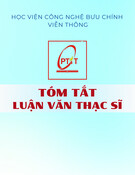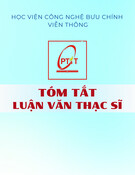
Annals of Mathematics
Bertini theorems
over finite fields
By Bjorn Poonen

Annals of Mathematics,160 (2004), 1099–1127
Bertini theorems over finite fields
By Bjorn Poonen*
Abstract
Let Xbe a smooth quasiprojective subscheme of Pnof dimension m≥0
over Fq. Then there exist homogeneous polynomials fover Fqfor which the
intersection of Xand the hypersurface f= 0 is smooth. In fact, the set of
such fhas a positive density, equal to ζX(m+1)
−1, where ζX(s)=ZX(q−s)is
the zeta function of X. An analogue for regular quasiprojective schemes over
Zis proved, assuming the abc conjecture and another conjecture.
1. Introduction
The classical Bertini theorems say that if a subscheme X⊆Pnhas a
certain property, then for a sufficiently general hyperplane H⊂Pn,H∩X
has the property too. For instance, if Xis a quasiprojective subscheme of Pn
that is smooth of dimension m≥0 over a field k, and Uis the set of points
uin the dual projective space ˇ
Pncorresponding to hyperplanes H⊂Pn
κ(u)
such that H∩Xis smooth of dimension m−1 over the residue field κ(u)of
u, then Ucontains a dense open subset of ˇ
Pn.Ifkis infinite, then U∩ˇ
Pn(k)
is nonempty, and hence one can find Hover k. But if kis finite, then it can
happen that the finitely many hyperplanes Hover kall fail to give a smooth
intersection H∩X; see Theorem 3.1.
N. M. Katz [Kat99] asked whether the Bertini theorem over finite fields
can be salvaged by allowing hypersurfaces of unbounded degree in place of
hyperplanes. (In fact he asked for a little more; see Section 3 for details.) We
answer the question affirmatively below. O. Gabber [Gab01, Corollary 1.6] has
independently proved the existence of good hypersurfaces of any sufficiently
large degree divisible by the characteristic of k.
*This research was supported by NSF grant DMS-9801104 and DMS-0301280 and a
Packard Fellowship. Part of the research was done while the author was enjoying the hospi-
tality of the Universit´e de Paris-Sud.

1100 BJORN POONEN
Let Fqbe a finite field of q=paelements. Let S=Fq[x0,...,x
n]be
the homogeneous coordinate ring of Pn, let Sd⊂Sbe the Fq-subspace of
homogeneous polynomials of degree d, and let Shomog =∞
d=0 Sd. For each
f∈Sd, let Hfbe the subscheme Proj(S/(f)) ⊆Pn. Typically (but not
always), Hfis a hypersurface of dimension n−1 defined by the equation
f= 0. Define the density of a subset P⊆Shomog by
µ(P) := lim
d→∞
#(P∩Sd)
#Sd
,
if the limit exists. For a scheme Xof finite type over Fq, define the zeta
function [Wei49]
ζX(s)=ZX(q−s):=
closed P∈X1−q−sdeg P−1= exp ∞
r=1
#X(Fqr)
rq−rs.
Theorem 1.1 (Bertini over finite fields).Let Xbe a smooth quasipro-
jective subscheme of Pnof dimension m≥0over Fq. Define
P:= {f∈Shomog :Hf∩Xis smooth of dimension m−1}.
Then µ(P)=ζX(m+1)
−1.
Remarks.
(1) The empty scheme is smooth of any dimension, including −1. Later (for
instance, in Theorem 1.3), we will similarly use the convention that if Pis
a point not on a scheme X, then for any r, the scheme Xis automatically
smooth of dimension rat P.
(2) In this paper, ∩denotes scheme-theoretic intersection (when applied to
schemes).
(3) If n≥2, the density is unchanged if we insist also that Hfbe a geomet-
rically integral hypersurface of dimension n−1. This follows from the
easy Proposition 2.7.
(4) The case n=1,X=A1, is a well-known polynomial analogue of the
fact that the set of squarefree integers has density ζ(2)−1=6/π2. See
Section 5 for a conjectural common generalization.
(5) The density is independent of the choice of embedding X֒→Pn!
(6) By [Dwo60], ζXis a rational function of q−s,soζX(m+1)
−1∈Q.
The overall plan of the proof is to start with all homogeneous polynomials
of degree d, and then for each closed point P∈Xto sieve out the polynomials
ffor which Hf∩Xis singular at P. The condition that Pbe singular on

BERTINI THEOREMS OVER FINITE FIELDS 1101
Hf∩Xamounts to m+ 1 linear conditions on the Taylor coefficients of a
dehomogenization of fat P, and these linear conditions are over the residue
field of P. Therefore one expects that the probability that Hf∩Xis nonsingular
at Pwill be 1 −q−(m+1) deg P. Assuming that these conditions at different P
are independent, the probability that Hf∩Xis nonsingular everywhere should
be
closed P∈X1−q−(m+1) deg P=ζX(m+1)
−1.
Unfortunately, the independence assumption and the individual singularity
probability estimates break down once deg Pbecomes large relative to d.
Therefore we must approximate our answer by truncating the product after
finitely many terms, say those corresponding to Pof degree <r. The main
difficulty of the proof, as with many sieve proofs, is in bounding the error of
the approximation, i.e., in showing that when d≫r≫1, the number of poly-
nomials of degree dsieved out by conditions at the infinitely many Pof degree
≥ris negligible.
In fact we will prove Theorem 1.1 as a special case of the following, which
is more versatile in applications. The effect of Tbelow is to prescribe the first
few terms of the Taylor expansions of the dehomogenizations of fat finitely
many closed points.
Theorem 1.2 (Bertini with Taylor conditions).Let Xbe a quasipro-
jective subscheme of Pnover Fq.LetZbe a finite subscheme of Pn,and
assume that U:= X−(Z∩X)is smooth of dimension m≥0. Fix a subset
T⊆H0(Z, OZ). Given f∈Sd,let f|Zbe the element of H0(Z, OZ)that
on each connected component Ziequals the restriction of x−d
jfto Zi,where
j=j(i)is the smallest j∈{0,1...,n}such that the coordinate xjis invert-
ible on Zi. Define
P:= {f∈Shomog :Hf∩Uis smooth of dimension m−1, and f|Z∈T}.
Then
µ(P)= #T
#H0(Z, OZ)ζU(m+1)
−1.
Using a formalism analogous to that of Lemma 20 of [PS99], we can deduce
the following even stronger version, which allows us to impose infinitely many
local conditions, provided that the conditions at most points are no more
stringent than the condition that the hypersurface intersect a given finite set
of varieties smoothly.
Theorem 1.3 (Infinitely many local conditions).For each closed point
Pof Pnover Fq,let µPbe normalized Haar measure on the completed local ring
ˆ
OPas an additive compact group,and let UPbe a subset of ˆ
OPwhose boundary

1102 BJORN POONEN
∂UPhas measure zero. Also for each P,fix a nonvanishing coordinate xj,and
for f∈Sdlet f|Pbe the image of x−d
jfin ˆ
OP. Assume that there exist smooth
quasiprojective subschemes X1,...,X
uof Pnof dimensions mi= dim Xiover
Fqsuch that for all but finitely many P,UPcontains f|Pwhenever f∈Shomog
is such that Hf∩Xiis smooth of dimension mi−1at Pfor all i. Define
P:= {f∈Shomog :f|P∈UPfor all closed points P∈Pn}.
Then µ(P)=
closed P∈Pn
µP(UP).
Remark.Implicit in Theorem 1.3 is the claim that the product PµP(UP)
always converges, and in particular that its value is zero if and only if µP(UP)
= 0 for some closed point P.
The proofs of Theorems 1.1, 1.2, and 1.3 are contained in Section 2. The
reader at this point is encouraged to jump to Section 3 for applications, and to
glance at Section 5, which shows that the abc conjecture and another conjec-
ture imply analogues of our main theorems for regular quasiprojective schemes
over Spec Z. The abc conjecture is needed to apply a multivariable gener-
alization [Poo03] of A. Granville’s result [Gra98] about squarefree values of
polynomials. For some open questions, see Sections 4 and 5.7, and also Con-
jecture 5.2.
The author hopes that the technique of Section 2 will prove useful in
removing the condition “assume that the ground field kis infinite” from other
theorems in the literature.
2. Bertini over finite fields: the closed point sieve
Sections 2.1, 2.2, and 2.3 are devoted to the proofs of Lemmas 2.2, 2.4,
and 2.6, which are the main results needed in Section 2.4 to prove Theorems
1.1, 1.2, and 1.3.
2.1. Singular points of low degree. Let A=Fq[x1,...,x
n] be the ring of
regular functions on the subset An:= {x0=0}⊆Pn, and identify Sdwith
the set of dehomogenizations A≤d={f∈A: deg f≤d}, where deg fdenotes
total degree.
Lemma 2.1. If Yis a finite subscheme of Pnover a field k,then the map
φd:Sd=H0(Pn,OPn(d)) →H0(Y,OY(d))
is surjective for d≥dim H0(Y,OY)−1.


























